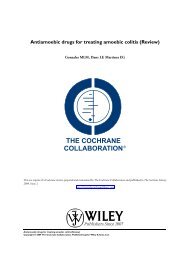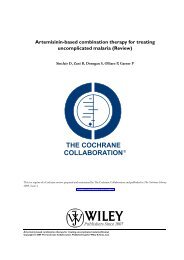Interventions for treating proximal humeral fractures in adults (Review)
Interventions for treating proximal humeral fractures in adults (Review)
Interventions for treating proximal humeral fractures in adults (Review)
Create successful ePaper yourself
Turn your PDF publications into a flip-book with our unique Google optimized e-Paper software.
ered when <strong>in</strong>terpret<strong>in</strong>g the results of trials, both <strong>in</strong> respect to the<br />
comparability and composition of the <strong>in</strong>tervention groups and <strong>in</strong><br />
the applicability of the f<strong>in</strong>d<strong>in</strong>gs of the trial. The limitations of the<br />
Neer classification scheme are also demonstrated by the identification<br />
of the valgus impacted four-part fracture, which has a lower<br />
risk of avascular necrosis. Ideally a fracture classification system<br />
should act as a guide to treatment as well to enable the comparison<br />
of results from studies of patients with similar fracture patterns.<br />
However, other factors, such as osteoporotic bone, associated soft<br />
tissue <strong>in</strong>jury and the patient’s overall health and motivation, will<br />
also <strong>in</strong>fluence treatment choices and outcome.<br />
Conservative management, generally <strong>in</strong>volv<strong>in</strong>g a period of arm<br />
immobilisation followed by physiotherapy, of (usually) m<strong>in</strong>imally<br />
displaced <strong>fractures</strong> is the basis of seven trials. There was a general<br />
recognition of the impaired function and serious complications<br />
such as shoulder-hand syndrome and reflex sympathetic dystrophy,<br />
that could follow a <strong>proximal</strong> <strong>humeral</strong> fracture. For example,<br />
Bertoft 1984 noted that follow<strong>in</strong>g <strong>in</strong>jury there is a marked tendency<br />
<strong>for</strong> the capsule of the shoulder jo<strong>in</strong>t to contract and <strong>for</strong> the<br />
deltoid muscle to atrophy, lead<strong>in</strong>g to stiffness and <strong>in</strong>ferior subluxation<br />
of the <strong>humeral</strong> head respectively. The extent and duration<br />
of <strong>in</strong>itial immobilisation are of primary importance. A balance<br />
is needed between the advantages of pa<strong>in</strong> relief and avoidance of<br />
fracture displacement, and the consequences of immobilisation,<br />
notably jo<strong>in</strong>t stiffness and muscle atrophy. There is limited evidence<br />
that the particular type of bandage used neither <strong>in</strong>fluences<br />
the time to fracture union nor the end functional result, although<br />
an arm sl<strong>in</strong>g was found to be generally more com<strong>for</strong>table than<br />
a body bandage (Rommens 1993). There is some evidence that<br />
limit<strong>in</strong>g immobilisation to one week rather than three weeks may<br />
result <strong>in</strong> less pa<strong>in</strong> <strong>in</strong> the short term without compromis<strong>in</strong>g longer<br />
term outcome (Kristiansen 1989). There is also some more reliable<br />
evidence that, <strong>for</strong> a specific group of undisplaced <strong>fractures</strong><br />
(two parts only), early physiotherapy (with<strong>in</strong> one week of fracture)<br />
without immobilisation compared with delayed physiotherapy<br />
after three weeks of immobilisation <strong>in</strong> a sl<strong>in</strong>g hastens recovery<br />
without serious complications <strong>in</strong>clud<strong>in</strong>g fracture displacement (<br />
Hodgson 2003). Hodgson 2003 presented consistent evidence of<br />
less pa<strong>in</strong> and a quicker and potentially better recovery of shoulder<br />
function <strong>in</strong> patients given immediate physiotherapy, without<br />
immobilisation (unless <strong>for</strong> com<strong>for</strong>t). Though Hodgson 2003 provides<br />
strong evidence <strong>in</strong> favour of early physiotherapy, and avoid<strong>in</strong>g<br />
rout<strong>in</strong>e immobilisation, <strong>in</strong> undisplaced two-part <strong>fractures</strong>, this<br />
is still a small study that might be affected by bias, particularly<br />
given that patients and care providers could not be bl<strong>in</strong>ded. A<br />
recent survey sent to senior hospital physiotherapists work<strong>in</strong>g directly<br />
with orthopaedic patients revealed large variation <strong>in</strong> rehabilitation,<br />
<strong>in</strong> particular with regards to rout<strong>in</strong>e immobilisation, duration<br />
of immobilisation and tim<strong>in</strong>g of first contact with a physiotherapist,<br />
with<strong>in</strong> and between hospitals <strong>in</strong> the UK (Hodgson<br />
2003a; Hodgson 2006). This po<strong>in</strong>ts to the need <strong>for</strong> a similar but<br />
larger and preferably multicentre trial test<strong>in</strong>g the same comparison<br />
<strong>Interventions</strong> <strong>for</strong> <strong>treat<strong>in</strong>g</strong> <strong>proximal</strong> <strong>humeral</strong> <strong>fractures</strong> <strong>in</strong> <strong>adults</strong> (<strong>Review</strong>)<br />
Copyright © 2008 The Cochrane Collaboration. Published by John Wiley & Sons, Ltd.<br />
as Hodgson 2003 to confirm the results of this trial and exam<strong>in</strong>e<br />
their applicability.<br />
In early versions of the review (up to Gibson 2002b), we suggested<br />
that s<strong>in</strong>ce fracture union does not occur <strong>in</strong> <strong>adults</strong> until at least<br />
six weeks after <strong>in</strong>jury, a comparative study with a longer period<br />
of immobilisation would be worthwhile. However, we withdrew<br />
this suggestion <strong>in</strong> the 2003 version (Handoll 2003) given that<br />
Hodgson 2003a (Hodgson 2006) had found that few <strong>fractures</strong> are<br />
immobilised <strong>for</strong> five or more weeks; thus, this suggestion seemed<br />
less appropriate as it flies aga<strong>in</strong>st current practice.<br />
Two trials (Bertoft 1984; Lundberg 1979) <strong>in</strong>vestigated whether<br />
patients could undertake their own physiotherapy after receiv<strong>in</strong>g<br />
appropriate <strong>in</strong>struction and with some monitor<strong>in</strong>g, rather than<br />
with full supervision. Conversely, one trial (Revay 1992) studied<br />
the supplementation of self-treatment with supervised group<br />
tra<strong>in</strong><strong>in</strong>g <strong>in</strong> a swimm<strong>in</strong>g pool. Their consensus that patients could<br />
generally achieve the desired end result with less supervision is<br />
not supported by sufficient evidence. In addition, all three trials<br />
were based <strong>in</strong> Sweden and possible differences <strong>in</strong> conventional<br />
physiotherapy regimens with<strong>in</strong> and between countries, then and<br />
now, also needs to be considered. There is some evidence from<br />
a Cochrane review on fall prevention that elderly people, if well<br />
<strong>in</strong>structed and with <strong>in</strong>tensive support (regular phone calls etc)<br />
can ma<strong>in</strong>ta<strong>in</strong> a home-based exercise programme (Gillespie 2003).<br />
However, there will still be some elderly patients with <strong>in</strong>sufficient<br />
understand<strong>in</strong>g or motivation to per<strong>for</strong>m the required exercises.<br />
Livesley 1992 hypothesised that pa<strong>in</strong> was associated with contracture<br />
of the capsule of the gleno<strong>humeral</strong> jo<strong>in</strong>t and that pulsed electromagnetic<br />
high frequency energy (PHFE) would reduce <strong>in</strong>flammation<br />
and swell<strong>in</strong>g, improv<strong>in</strong>g the end functional result. However,<br />
the trial failed to provide any quantitative data to support or<br />
refute this hypothesis.<br />
Primary fracture reduction is an important factor <strong>in</strong> heal<strong>in</strong>g and<br />
the better anatomical results <strong>in</strong> the surgical group <strong>in</strong> Kristiansen<br />
1988 would be commonly expected. However, accurate fracture<br />
reduction is not <strong>in</strong>variably associated with a complete recovery<br />
of function and conversely excellent shoulder function may<br />
be rega<strong>in</strong>ed after less than optimal fracture reduction. Although<br />
Kristiansen 1988 concluded that external fixation gave “better reduction,<br />
safer heal<strong>in</strong>g and superior function” than closed manipulation,<br />
their results were not statistically significant. The small<br />
number of patients <strong>in</strong> this trial, and the even smaller number <strong>in</strong>cluded<br />
at f<strong>in</strong>al follow up, were <strong>in</strong>sufficient to demonstrate a better<br />
functional outcome follow<strong>in</strong>g either treatment.<br />
The displacement of fracture fragments <strong>in</strong> three and four-part<br />
<strong>fractures</strong> compromises heal<strong>in</strong>g unless an adequate, usually open,<br />
reduction and stabilisation is per<strong>for</strong>med. Only two trials related<br />
outcome to quality of reduction (Kristiansen 1988; Zyto 1997)<br />
and both were too small to draw more than very tentative conclusions<br />
of effect. Cerclage or tension band wir<strong>in</strong>g was not shown<br />
13








